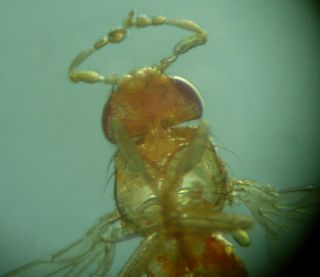Related Research Articles

A homeobox is a DNA sequence, around 180 base pairs long, that regulates large-scale anatomical features in the early stages of embryonic development. Mutations in a homeobox may change large-scale anatomical features of the full-grown organism.
In the vertebrate embryo, a rhombomere is a transiently divided segment of the developing neural tube, within the hindbrain region in the area that will eventually become the rhombencephalon. The rhombomeres appear as a series of slightly constricted swellings in the neural tube, caudal to the cephalic flexure. In human embryonic development, the rhombomeres are present by day 29.

In evolutionary developmental biology, homeosis is the transformation of one organ into another, arising from mutation in or misexpression of certain developmentally critical genes, specifically homeotic genes. In animals, these developmental genes specifically control the development of organs on their anteroposterior axis. In plants, however, the developmental genes affected by homeosis may control anything from the development of a stamen or petals to the development of chlorophyll. Homeosis may be caused by mutations in Hox genes, found in animals, or others such as the MADS-box family in plants. Homeosis is a characteristic that has helped insects become as successful and diverse as they are.
Hox genes, a subset of homeobox genes, are a group of related genes that specify regions of the body plan of an embryo along the head-tail axis of animals. Hox proteins encode and specify the characteristics of 'position', ensuring that the correct structures form in the correct places of the body. For example, Hox genes in insects specify which appendages form on a segment, and Hox genes in vertebrates specify the types and shape of vertebrae that will form. In segmented animals, Hox proteins thus confer segmental or positional identity, but do not form the actual segments themselves.

Homeobox protein Hox-B6 is a protein that in humans is encoded by the HOXB6 gene.

Homeobox protein Hox-C8 is a protein that in humans is encoded by the HOXC8 gene.

Homeobox protein Hox-D13 is a protein that in humans is encoded by the HOXD13 gene. This gene belongs to the homeobox family of genes. The homeobox genes encode a highly conserved family of transcription factors that play an important role in morphogenesis in all multicellular organisms.

Homeobox protein Hox-B1 is a protein that in humans is encoded by the HOXB1 gene.

Homeobox protein Hox-B2 is a protein that in humans is encoded by the HOXB2 gene.

Homeobox protein Hox-D3 is a protein that in humans is encoded by the HOXD3 gene.

Homeobox protein Hox-B13 is a protein that in humans is encoded by the HOXB13 gene.

Homeobox protein Hox-A3 is a protein that in humans is encoded by the HOXA3 gene.

Homeobox protein Hox-C13 is a protein that in humans is encoded by the HOXC13 gene.

Homeobox protein Hox-B8 is a protein that in humans is encoded by the HOXB8 gene.

Homeobox protein Hox-C10 is a protein that in humans is encoded by the HOXC10 gene.

Homeobox protein Hox-C11 is a protein that in humans is encoded by the HOXC11 gene.

Andrew Gino Lumsden is an English neurobiologist, Emeritus Professor of the University of London and founder in 2000 of the Medical Research Council Centre for Developmental Neurobiology at King's College London.

Athanasia Papalopulu is a Wellcome Trust senior research fellow and Professor of Developmental Neuroscience in the School of Biological Sciences, University of Manchester.
Segmentation is the physical characteristic by which the human body is divided into repeating subunits called segments arranged along a longitudinal axis. In humans, the segmentation characteristic observed in the nervous system is of biological and evolutionary significance. Segmentation is a crucial developmental process involved in the patterning and segregation of groups of cells with different features, generating regional properties for such cell groups and organizing them both within the tissues as well as along the embryonic axis.

Hox genes play a massive role in some amphibians and reptiles in their ability to regenerate lost limbs, especially HoxA and HoxD genes.
References
- ↑ Papalopoulou, Athanasia (1991). Analysis of vertebrate homeobox containing genes. ucl.ac.uk (PhD thesis). University of London. OCLC 1170168705. EThOS uk.bl.ethos.815786.

- 1 2 3 4 "Krumlauf Lab | Stowers Institute for Medical Research". www.stowers.org.
- 1 2 3 "Robb Krumlauf". www.nasonline.org. Retrieved 2020-04-19.
- ↑ Graham, A.; Papalopulu, N.; Krumlauf, R. (1989-05-05). "The murine and Drosophila homeobox gene complexes have common features of organization and expression". Cell. 57 (3): 367–378. doi:10.1016/0092-8674(89)90912-4. ISSN 0092-8674. PMID 2566383. S2CID 22259601.
- ↑ Papalopulu, N; Lovell-Badge, R; Krumlauf, R (1991-10-25). "The expression of murine Hox-2 genes is dependent on the differentiation pathway and displays a collinear sensitivity to retinoic acid in F9 cells and Xenopus embryos". Nucleic Acids Research. 19 (20): 5497–5506. doi:10.1093/nar/19.20.5497. ISSN 0305-1048. PMC 328948 . PMID 1682879.
- 1 2 Studer, M.; Lumsden, A.; Ariza-McNaughton, L.; Bradley, A.; Krumlauf, R. (19–26 December 1996). "Altered segmental identity and abnormal migration of motor neurons in mice lacking Hoxb-1". Nature. 384 (6610): 630–634. Bibcode:1996Natur.384..630S. doi:10.1038/384630a0. ISSN 0028-0836. PMID 8967950. S2CID 4317559.
- ↑ Vieux-Rochas, Maxence; Mascrez, Bénédicte; Krumlauf, Robb; Duboule, Denis (2013-10-01). "Combined function of HoxA and HoxB clusters in neural crest cells". Developmental Biology. 382 (1): 293–301. doi: 10.1016/j.ydbio.2013.06.027 . ISSN 1095-564X. PMID 23850771.
- ↑ Parker, Hugo J.; Bronner, Marianne E.; Krumlauf, Robb (2014-10-23). "A Hox regulatory network of hindbrain segmentation is conserved to the base of vertebrates". Nature. 514 (7523): 490–493. Bibcode:2014Natur.514..490P. doi:10.1038/nature13723. ISSN 1476-4687. PMC 4209185 . PMID 25219855.
- ↑ Parker, Hugo J.; Krumlauf, Robb (November 2017). "Segmental arithmetic: summing up the Hox gene regulatory network for hindbrain development in chordates". Wiley Interdisciplinary Reviews. Developmental Biology. 6 (6): e286. doi:10.1002/wdev.286. ISSN 1759-7692. PMID 28771970. S2CID 3849662.
- ↑ Lumsden, A.; Krumlauf, R. (1996-11-15). "Patterning the vertebrate neuraxis". Science. 274 (5290): 1109–1115. Bibcode:1996Sci...274.1109L. doi:10.1126/science.274.5290.1109. ISSN 0036-8075. PMID 8895453. S2CID 10891464.
- ↑ Aparicio, S.; Hawker, K.; Cottage, A.; Mikawa, Y.; Zuo, L.; Venkatesh, B.; Chen, E.; Krumlauf, R.; Brenner, S. (1997). "Organization of the Fugu rubripes Hox clusters: evidence for continuing evolution of vertebrate Hox complexes". Nature Genetics. 16 (1): 79–83. doi:10.1038/ng0597-79. ISSN 1061-4036. PMID 9140399. S2CID 12434208.
- ↑ Itasaki, N.; Bel-Vialar, S.; Krumlauf, R. (1999). "'Shocking' developments in chick embryology: electroporation and in ovo gene expression". Nature Cell Biology. 1 (8): E203–207. doi:10.1038/70231. ISSN 1465-7392. PMID 10587659. S2CID 205096435.
- ↑ "Robert Eugene Krumlauf". American Academy of Arts & Sciences. 2023-05-26. Retrieved 2023-05-26.
- ↑ "Society for Developmental Biology | Resource". www.sdbonline.org. Retrieved 2020-04-19.